#Seattle Construction Tips
Explore tagged Tumblr posts
Text
Everything You Require to Understand about a Building Permit in Seattle

If this is your first permit process in Seattle, it may not seem very safe. But, if you understand your requirements and follow a proper step-by-step approach, then it’s easy. Getting the appropriate building permit is critical to build a new home or remodel an older property.
A Seattle building permit requirement
The building permit is an official document needed to begin construction, renovation or structural modification works. Here’s why it’s crucial:
Compliance with Laws: Conforms to local zoning regulations and building codes.
Safety Assurance: Public safety and the structural integrity of buildings are protected.
Avoidance of Penalties: It prevents legal issues, project shutdowns and associated fines.
Losing a permit can stop you from working and cause you legal trouble.
What Kinds Of Projects In Seattle Need A Permit?
Building permits are required for:
New constructions.
And cons include major renovations or remodels.
Such as the removal or addition of Walls.
Installing of decks, fences, or retaining walls over a certain height.
You usually don’t need a permit if you’re painting or doing some minor repairs, but you can never know for sure.
Remodeling Requirements in Seattle, WA
Before applying, gather the necessary documentation and ensure your project meets these prerequisites:
Project Plans:
Architectural and structural drawings in detail.
Property lines and project location are shown on site plans.
Zoning Information:
Confirm compliance with Seattle zoning laws, which, among other things, limit height, setbacks, and use of land.
Environmental Compliance:
Suppose your project is near wetlands or steep slopes, for example. In that case, you must determine whether your project requires an environmental review.
Licensed Contractor Information:
If you have a licensed contractor, provide details of him.
Permit Fees:
The fees depend on your project's size and value.
Building Permit Application in Seattle
Follow these steps to streamline the application process:
Understand Your Project’s Needs:
To determine what permits are required, look at the Seattle Department of Construction and Inspections (SDCI) website.
Express licenses may be available for smaller projects.
Prepare Your Application Materials:
Floor plans, elevations, structural calculations and energy code compliance forms are included.
Submit Your Application:
To apply online, use the Seattle Services Portal.
To obtain the passport, you must adequately upload all the required documents and provide a detailed project description.
Pay the Permit Fees:
You can pay your fees online or in person.
Wait for the Review Process:
Plan checks, zoning compliance, and environmental assessments by the SDCI will review your application.
Address Corrections Promptly:
If reviewers raise issues, answer swiftly and politely to avoid delay.
Schedule Inspections:
Once you have your permit, you must schedule inspections at different phases of your construction process.
Tips for your successful permit application.
Double-Check Your Plans: Complete and accurate documentation is needed before submission.
Hire Professionals: If you have architects or contractors who work with Seattle’s building codes, then you can work with them to navigate the process with ease.
Apply Early: Plan accordingly; permit processing takes weeks or months (depending on the permit).
Monitor Application Status: To stay updated on your application, use the Seattle Services Portal.
Seattle Building permits have unique challenges.
Seattle’s climate and architectural diversity present specific challenges:
Environmental Factors: High humidity and rain will influence some construction timelines and material choices.
Zoning Restrictions: Projects must fit into the city’s rigid zoning ordinances.
Architectural Styles: Seattle’s juxtaposition of modern with traditional requires specific responses.
Partnering with professionals who understand these nuances makes you feel confident about your permit process.
When Is No Building Permit Required?
Although permits are essential for significant projects, their need is not critical for minor projects like painting, tiling, or minor repairs. But it’s always safer to double-check with the SDCI.
Conclusion
Getting a building permit in Seattle ensures you don't build your construction project without following local laws and standards. Following a systematic approach (understanding requirements, thorough documentation, etc.) with experienced professionals will save you time, spare you complications, and bring your project to life successfully.
Whether building a new home or updating an existing one, having proper permits in place is essential to a smooth and trouble-free experience. If you plan, you'll be confident you can complete your project.
#Seattle Building Permits#Building Permit Process#Construction Regulations Seattle#Zoning Compliance Seattle#Environmental Review Seattle Projects#Home Renovation Permits Seattle#SDCI Permit Guidelines#Building Code Requirements Seattle#Architectural Plans for Permits#Seattle Construction Tips
0 notes
Text
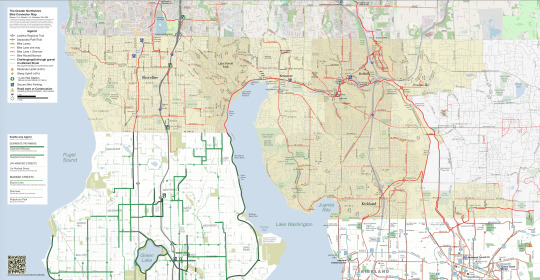
Maps Release: Greater Northshore Bike Connector, MEGAMAP 1.4.5
Greater Northshore Bike Connector Map 1.4.5 – 13 December 2024 – is now available on github, as is MEGAMAP 1.4.5 a pasteup of Greater Northshore, City of Seattle, 2 Line Eastside Bike Connector, and a little bit of King County Regional Trails to get us all the way to the south end of Lake Washington.
Changes since 1.4.3 (since I apparently never posted about 1.4.4 here?! so you get a double-dose):
The full long-term remapping of Montlake Boulevard at SR-520 with the new bike/pedestrian bridge. It was supposedly going to be soft-open today, with opening ceremony tomorrow (14 December) but it’s not open yet and landscaping clearly isn’t done. I think it’s open enough for tomorrow but I suspect there will be landscaping-related closures. (MEGAMAP only)
New Safe/Neighbourhood Greenway streets in northern Lake City (already open; Greater Northshore and MEGAMAP)
Improved bike lanes/partial off-street lanes in Redmond on 152nd Ave NE north of NE 24th St. (already open; MEGAMAP only)
Yet another correction to Seattle’s map showing NW 125th between Interurban and Aurora as sharrows, not bike lanes (thank you, @[email protected]) (Greater Northshore and MEGAMAP)
Construction warning flag removed with the end of Burke-Gilman repaving in Bothell (Greater Northshore and MEGAMAP)
All permalinks continue to work.
If you enjoy these maps and feel like throwing some change at the tip jar, here’s my patreon. Patreon supports get things like pre-sliced printables of the Greater Northshore, and also the completely-uncompressed MEGAMAP, not that the .jpg has much compression in it because it doesn’t. If you have an iPhone, please use the website interface and not the app, because Apple takes 30% if you use the app. I’ll keep doing this regardless, but you know. Thank you! ^_^
#bike#bike map#bicycle#bicycling#bicyclist#maps#map#bike maps#seattle#northshore#shoreline#lake forest park#kenmore#juanita#bothell#woodinville#king county#redmond#kirkland#bellevue
5 notes
·
View notes
Text
DIY Paper Hellebore
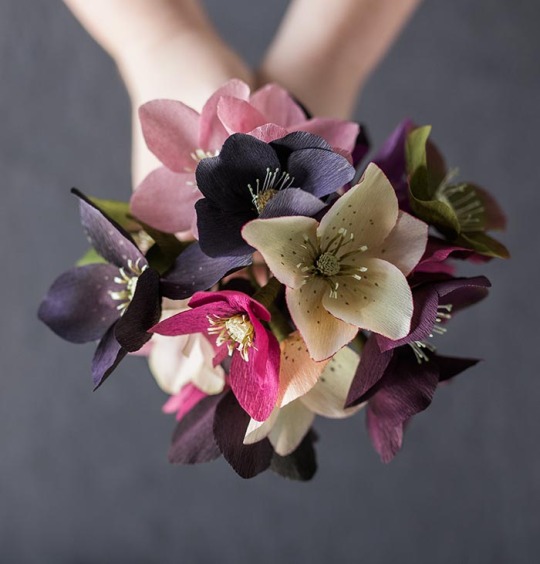
Project by Kate Alarcón:
When I had the opportunity to prepare a flower-making workshop for a Carpe Diem Collective event in Seattle, I knew the hellebore would be perfect. It grows beautifully in the Pacific Northwest, but still feels a little bit exotic and unexpected. Its subtle yet rich colors seem sophisticated in a way that struck me as ideal for the design-savvy makers whom I knew would be attending. But what was most exciting to me were the opportunities the hellebore presented to play with color and pattern. Rather than prescribing one specific variety for everyone to make, I taught several techniques, and everyone played with variations. As the new flower-makers worked, I found myself continually surprised and delighted by the varieties that sprung to life around the table.
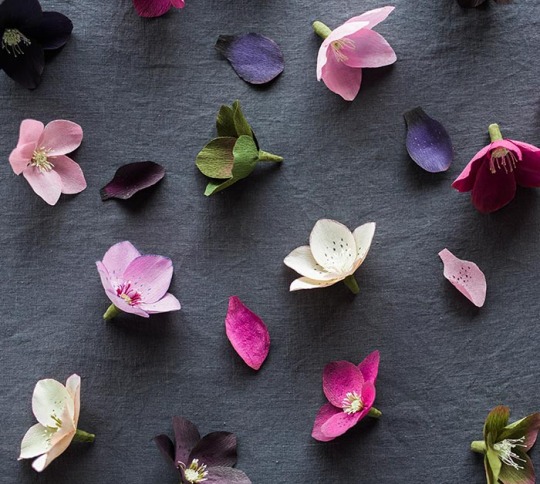
In that spirit, the instructions that follow demonstrate techniques for construction and for adding color and detail. I hope you’ll spend some time observing the hellebores blooming around you right now (or on Pinterest!) and combine these techniques to please your own artist’s eye. And special thanks to the women who attended the hellebore workshop and whose creativity inspired the hellebores I’ve made here. —Kate
Photos and styling by Grace Kim
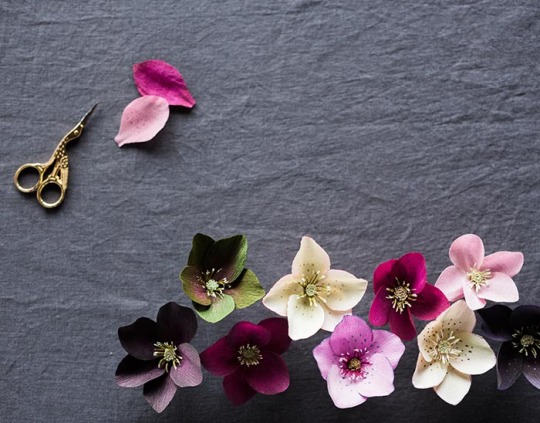
About Kate: Kate Alarcón makes delicate and unusual paper plants and flowers just outside Seattle. Kate chose the cobra lily — a carnivorous plant native to the West Coast — as her business name and spirit “animal” because she finds so much inspiration in its eccentric, otherworldly beauty. She takes custom orders via her website, and teaches flower-making workshops in the Pacific Northwest. You can see her newest work on Instagram @cobralilyshop.
About Grace: Grace Kim is dedicated to capturing and creating beauty and helping people live life to the fullest. You can find her work at GH Kim Photography and Carpe Diem Collective. Follow her on Instagram @graceperdiem.
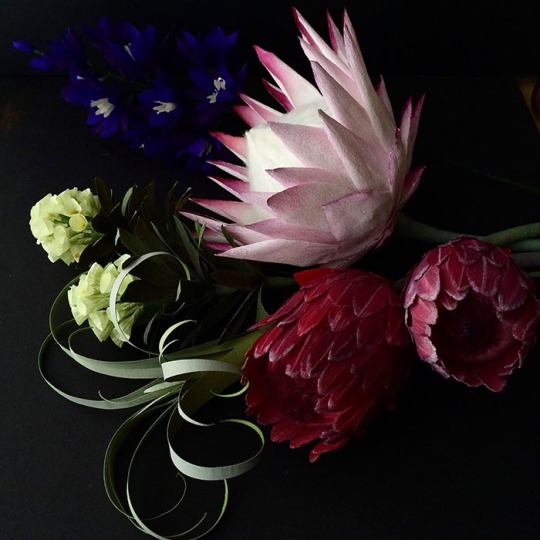
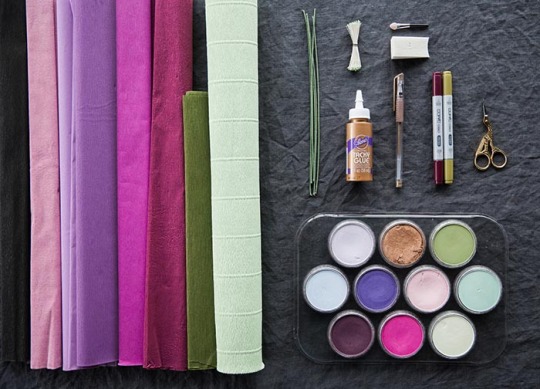
Supplies
For flower construction:
• hellebore templates (download here) • Aleene’s Original Tacky Glue • fine or doublette crepe paper (black, white, dark red, pinks, violets, and greens are all suitable) plus olive green to wrap the stem • pale green or yellow florist crepe for the flower center • 1 10-inch length of 18-gauge, cloth-covered stem wire • paper scissors • optional: small green or yellow millinery stamens
For adding color and detail:
• Copic Sketch or Ciao Markers. I find the following colors especially nice for hellebores: RV69, V15, V12, V91, YG95, and YG03, G20, 0. • PanPastels. If I were to buy just one color for this project, it would be 430.5 Magenta, which creates a very rich, deep pink when swiped over black crepe paper. Other nice additions would be: 470.5 Violet, 930.5 Bronze, 430.1 Magenta Extra Dark, 680.3 Bright Yellow Green Shade, 640.8 Permanent Green Tint, , 340.8 Permanent Red Tint, 220.8 Hansa Yellow Tint, 520.8 Ultramarine Blue Tint, 470.8 Violet Tint • cosmetic wedge sponge • eye-shadow brush with a sponge-tip applicator or cotton swab • gold gel pen
Creating the center:
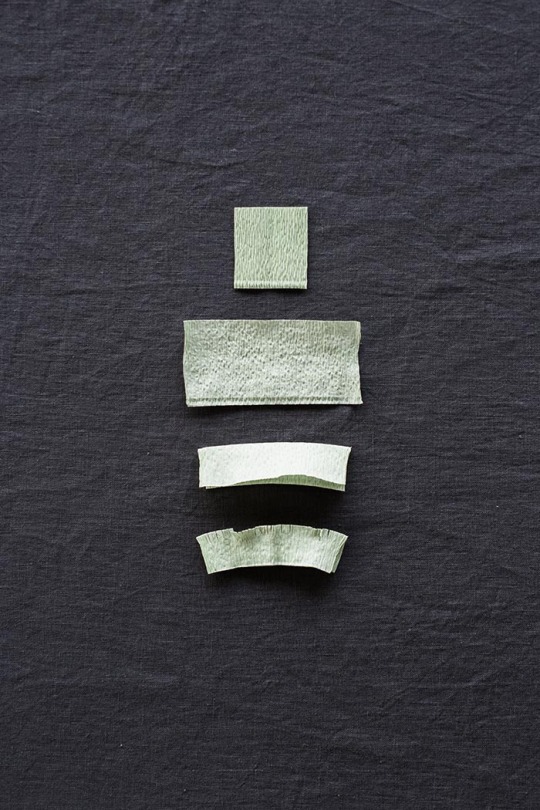
Image above: Each piece represents one step in the process of making the hellebore center.
Using template A, cut out a rectangle from the pale green crepe.
Stretch this piece against the grain, pulling out all the tiny folds so that you have a long rectangle. Fold the rectangle in half lengthwise.
Create a short fringe along the fold by making a row of small cuts very close together (roughly 1/16th of an inch apart).
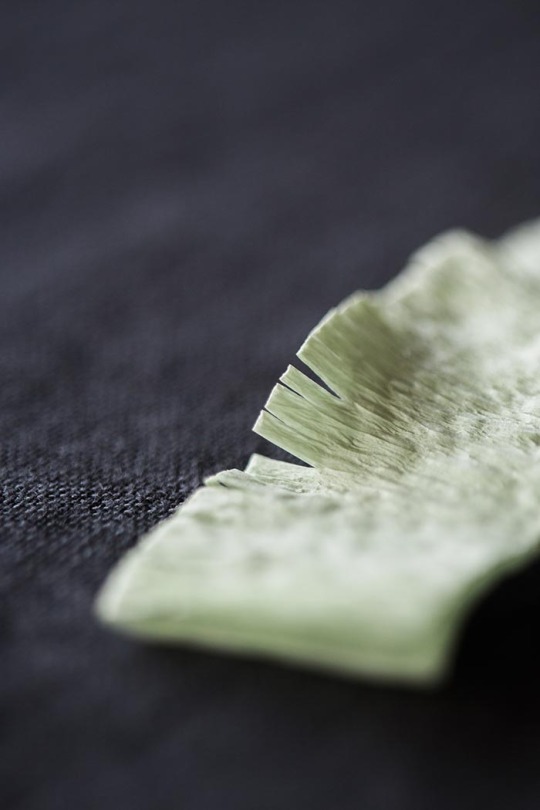
Image above: The short fringe along the fold of the rectangle.

Image above: Rolling the center around the stem.
Using template B as a guide, cut the folded rectangle so that it tapers toward one end of the rectangle. (This will help create a smooth transition between the flower center and the stem.) Dot glue inside the fold along the whole length of the rectangle, just below the fringe. Insert the tip of your stem wire into the fold on the wider end of the rectangle just below the fringe, and use your finger to press the fold closed. Let this dry for a minute.
Then dot glue along one side of the rectangle beneath the fringe, and roll the rectangle up around the wire. The fringes should be even, creating a flat, circular plane at the top of your center.
Adding stamens:
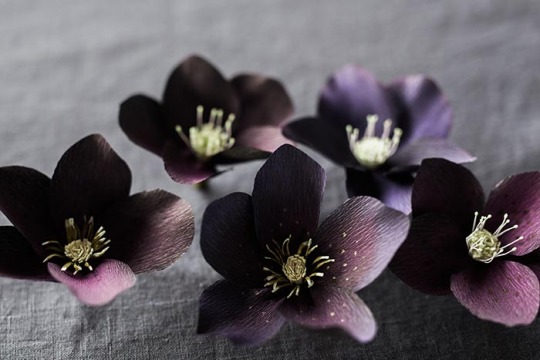
Image above: The flower on the right has millinery stamens; the middle and left, DIY paper stamens.
You can purchase double-headed millinery stamens from Castle in the Air or Rose Mille (see suppliers below). To attach, you just fold or cut them in half and glue them around your center, so that the stamen tip extends about a half inch beyond the top of your fringed center. You don’t need to be too precise about the number of stamens you add to each flower — some variation will look more natural.
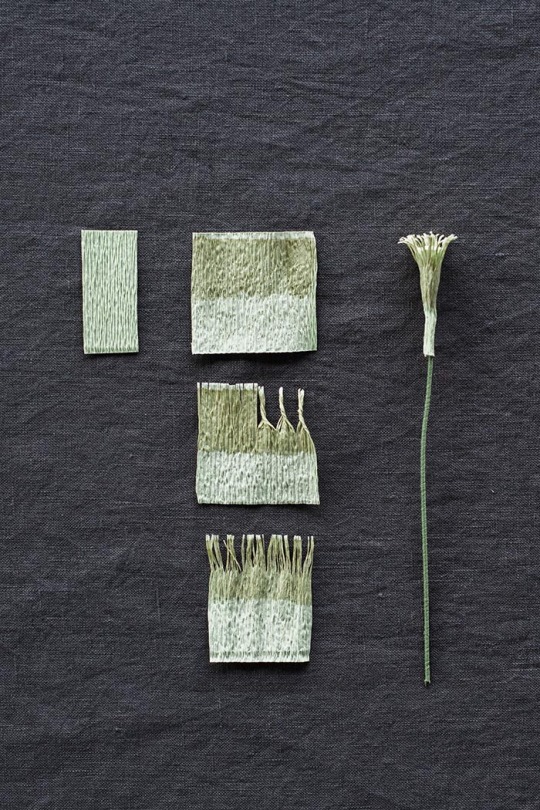
To make your own paper stamens, use template C to cut a small rectangle from the pale green crepe. Stretch this rectangle all the way out across the grain. Use a green marker (Copic YG 95 is perfect, but almost any type of marker is suitable for this step) to color in a very wide stripe about 1/8th inch from the top to about an inch from the bottom. If you find that the uncolored strip across the top is too wide, just trim it with your scissors.
Create a fringe across the grain by making a series of ¾ inch cuts very close together. Then, working in small sections, gently but firmly twist these stamens together in one direction and then in the other.
Untwist all the stamens and use your fingers to straighten them. If they resist finger-straightening, use your scissors to very gently scrape the length of the stamens on one side and then the other.
Finally, scrape the tips of the stamens between your thumb and scissor blade to curl them slightly.
Dot glue in a zigzag along the lower half of this strip of stamens, and then wrap it around the green center, so that the tips of the stamens extend about ½ inch past the top of the center. (If you’d like a fuller set of stamens, use the whole strip, which should wrap around twice. For a wispier set, snip the strip of stamens after you’ve wrapped the center once, and save the other half for another flower.)
Insert your finger into the middle of the stamens and very gently press them outward so that they slightly lean away from the center. Gently separate any stamens that are sticking together, and touch up your curled ends if necessary. Let this center dry while you cut and color your petals.
For the petals:
A note about grain:
The grain of the crepe paper runs parallel to the roll or fold. Crepe paper stretches horizontally, but not vertically, so you will almost always cut petals with the grain, placing the template so that the tiny wrinkles in the paper run up and down the template, not across.
Use any of the petal templates to cut out five petals for each flower. I’ve included three templates so you have the option to create some variation among your hellebores, but you’ll only use one template to cut all five of the petals for each flower.
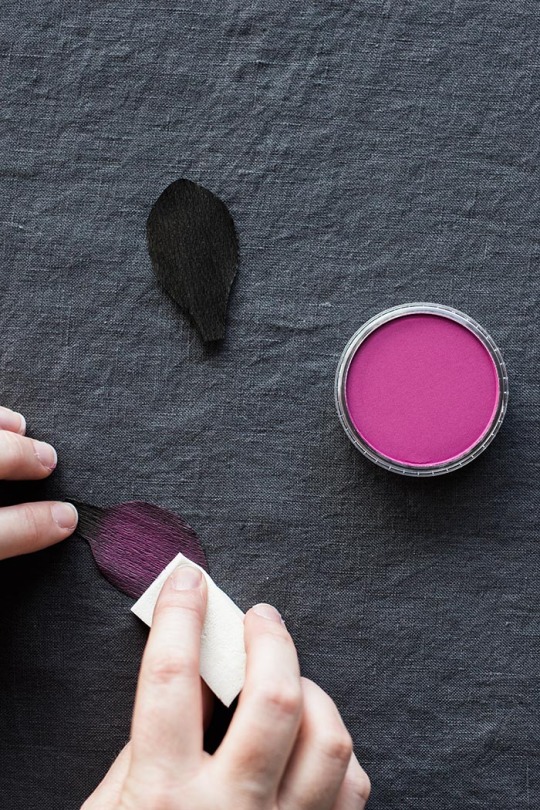
Image above: Applying a “wash” of PanPastel.
The PanPastels can add details like darkened petal edges or gradient color, but I like them best for adding a “wash” of color to the whole petal, which helps to recreate the hellebore’s subtle, complex coloring. I find that an inexpensive cosmetic wedge sponge works fine for this. A cotton swab or eye shadow brush is also suitable for finer detail, like a colored edge.
To create the very dark hellebores, use black crepe for the petals and then gently swipe on a layer of any of the darker, richer colors. My favorite is the 430.5 Magenta.
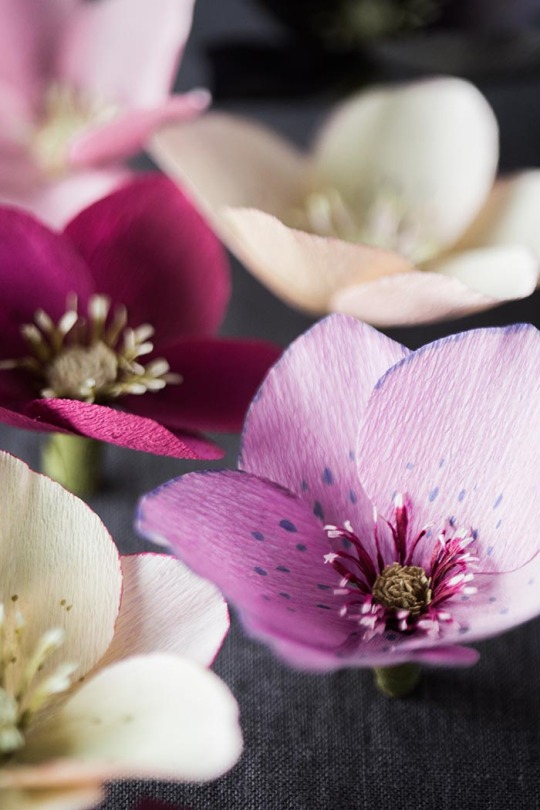
Image above: The PanPastels can add some subtlety to crepe paper colors that are a little too pure and bright to be suitable for a hellebore. Here, I’ve used a soft pink to tone down a bright violet.
The Copic markers can be used to add color to an entire petal, to create speckles near the petal’s base, or to darken its outer edge. You can also use multiple markers that are the same hue but different intensities to create a gradient effect, beginning with the darkest color at the base of the petal and ending with the lightest at the top edge. The colorless blender can help to blend any hard lines between the different colors.
For dots, just barely touch the fine tip of the marker to the petal, lifting immediately. If the dots look too stark, a very light layer of PanPastel over the top can help them “sink in” to the petal and look more natural.
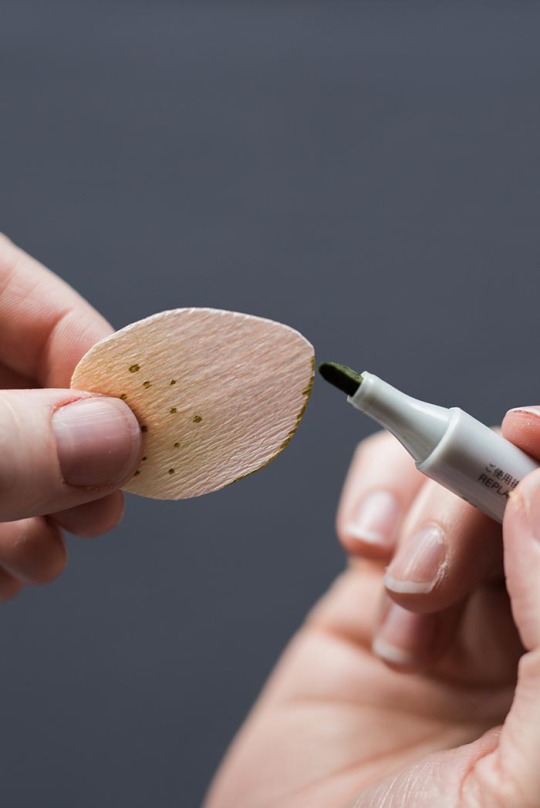
To color the edges, barely touch the broad tip of the marker to the very edge of the petal, rather than trying to draw a very thin line on the front of the petal.
Gel pens: I use a gold gel pen to add speckles to my black hellebores — I like how they add a subtle twinkle.

Image above: Steps for two sample petal variations.
For the deep magenta petal, first swipe the 430.5 Magenta PanPastel over the entire black petal. Next, use a small makeup brush or cotton swab to apply 470.5 Violet PanPastel just along the edge of the petal. Then, use the gold gel pen to add dots on the bottom third of the petal.
For the pink petal, swipe 220.8 Hansa Yellow Tint PanPastel over the bottom third of the petal. Next, use the fine tip of Copic YG95 to add dots along the bottom of the petal. Then, use the square tip of this same marker to add color to the edge of the petal.
I’ve included nine other hellebore petal “recipes” at the end of the tutorial.
Shaping the petals:
To make the petals more lifelike, you can gently cup them near the base, curl them slightly by scraping them gently between your thumb and the edge of a pair of scissors, and stretch the petal edge gently to create a slight frill. Before you accidentally tear your beautifully decorated petals, practice on some blank petals to get a feel for the point at which the paper rips. It doesn’t take much shaping to mimic a hellebore petal, so you can afford to be gentle.
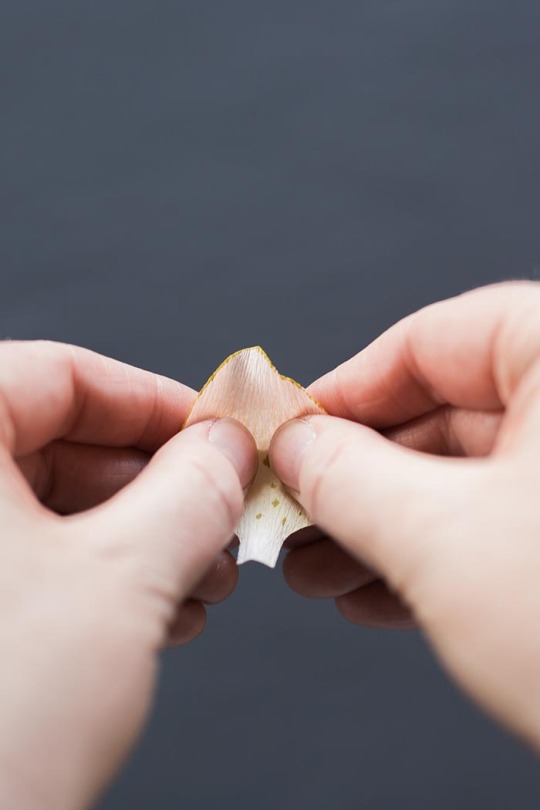
To cup the base of the hellebore petal, hold it gently with two hands, thumbs in front, and gently stretch by pushing your thumbs slightly forward and pulling back and outward with your index fingers. Hellebore petals don’t require very deep cups.
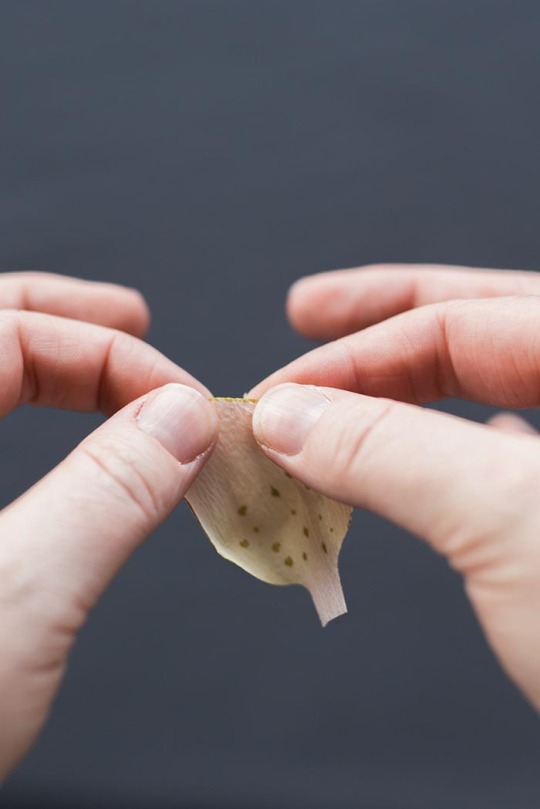
Frill your edge slightly by gently stretching it.
Building the flower:
Place the base of the petal between your thumb and the blade of your scissors, and gently scrape the underside of the bottom of the petal, so that it curls slightly. This will help the petals to lie flat, rather than standing up and covering your center.
Dot a small amount of glue on the base of a petal and press it against the edge of your stamen-covered center. Then do the same with the next petal, placing it to the left of and slightly behind the first petal.
Directly across from the point where the first two petals overlap, place your third petal.
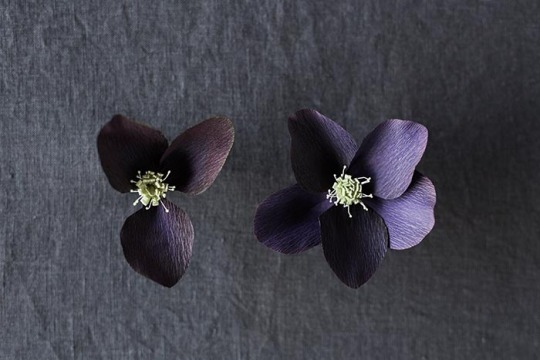
Image above: The flower on the left shows placement of the first three petals. The gaps on either side are where you’ll place your remaining two petals.
Now you’ll have a space on either side of this last petal. In the space between this petal and your first petal, place your fourth petal. In the remaining space, place your final petal.
Let the glue dry completely.
Finishing the flower:
Cut an 8-inch-long and 1/3” wide strip of olive green fine crepe across the grain. Apply very small dots of glue along the length of this strip and attach it to the part of the wire that is covered by the base of your petals. With your left hand, hold the strip at a 45-degree angle to the wire and gently stretch as you twirl the wire with your right hand.

Wrap to the bottom of the wire, and snip the excess strip. Gently adjust the petals and stamens if needed. But there’s no need to be too fussy — paper hellebores are at their most charming when they’re allowed to be a little bit quirky.
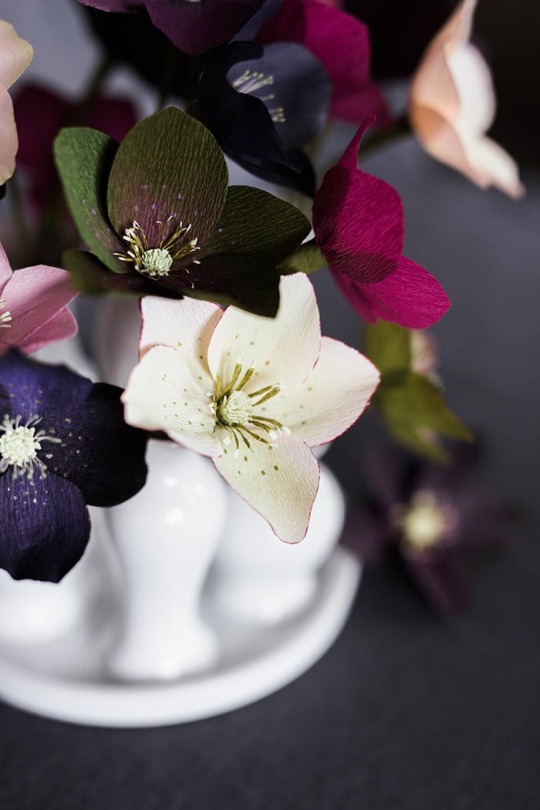
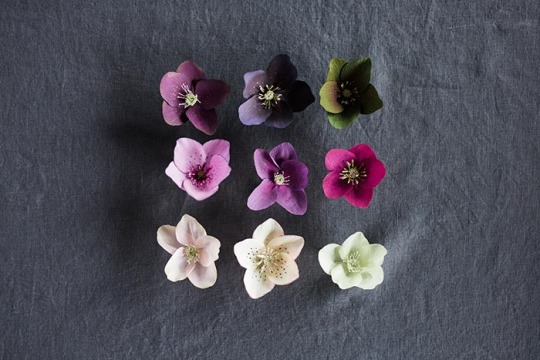
Additional hellebore recipes:
Row 1: 1. Black fine crepe, a wash of 430.5 Magenta PanPastel, 930.5 Bronze PanPastel edges, gold dots, and millinery stamens. 2. Black fine crepe, a wash of 430.1 Magenta Extra Dark PanPastel, a 470.5 Violet PanPastel edge, gold dots, and paper stamens 3. Deep olive doublette crepe, 430.5 Magenta PanPastel on the bottom third of the petal, and paper stamens
Row 2: 1. Lavender doublette crepe, Copic BV01 dots and petal edging, and paper stamens (for these I used Copic RV69 to make the stamens maroon instead of green.) 2. Sangria fine crepe, 430.5 Magenta PanPastel on the bottom third of the petals, gold dots, and millinery stamens 3. Cherry fine crepe, 430.5 Magenta PanPastel on the bottom third of the petals, gold dots, and paper stamens.
Row 3: 1. Pink fine crepe, a wash of 340.8 Permanent Red Tint PanPastel, and millinery stamens 2. Pink doublette crepe, 220.8 Hansa Yellow Tint PanPastel, Copic RV69 dots, dark maroon PanPastel on the edges, and paper stamens (for these stamens, I just colored the tips with a pale yellow.) 3. White fine crape, a wash of 680.3 Bright Yellow Green Shade PanPastel, and millinery stamens.
Sources for supplies:
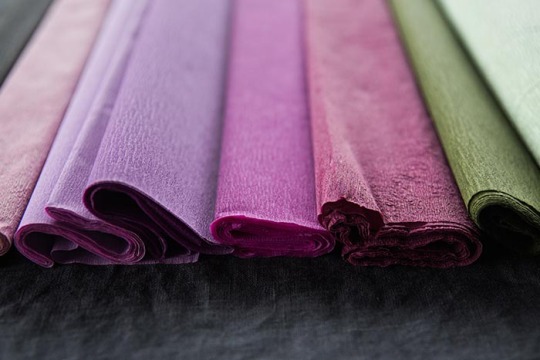
Castle in the Air: crepe paper, stem wire, stamens
Rose Mille: crepe paper, stamens
Dick Blick Art Materials: PanPastels
Aaron Brothers: PanPastels
Michaels Craft Stores: 18 gauge floral wire
Impress Cards and Crafts: If you live in the Seattle area, Impress has crepe paper in three different weights, Aleene’s glue, and a great selection of Copic Markers and gel pens.
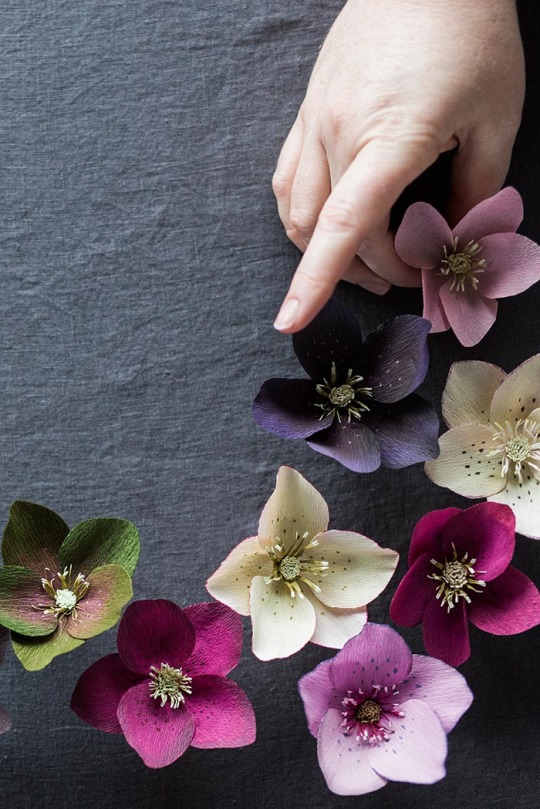
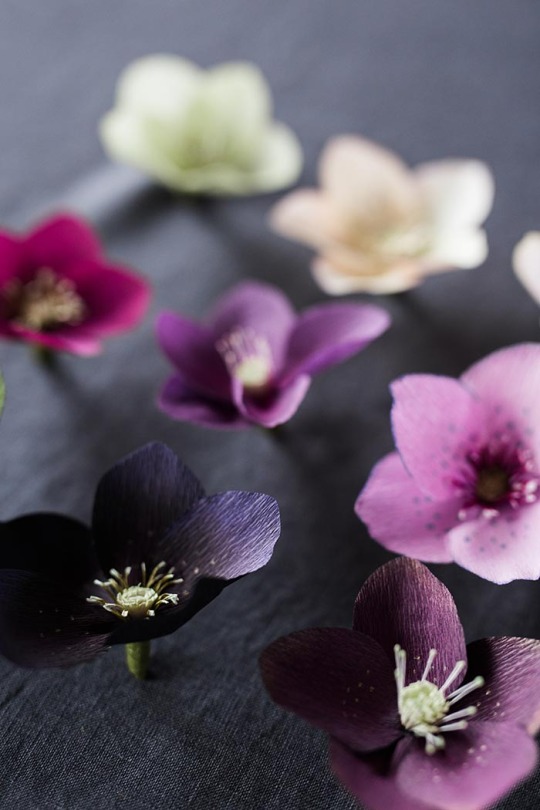
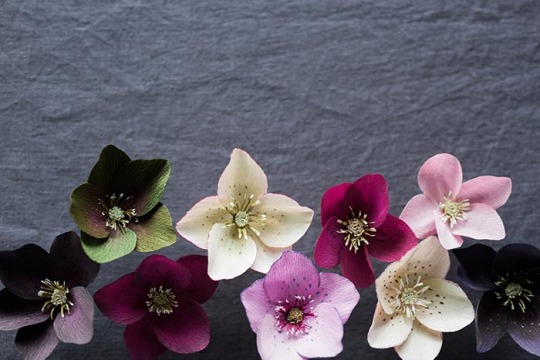
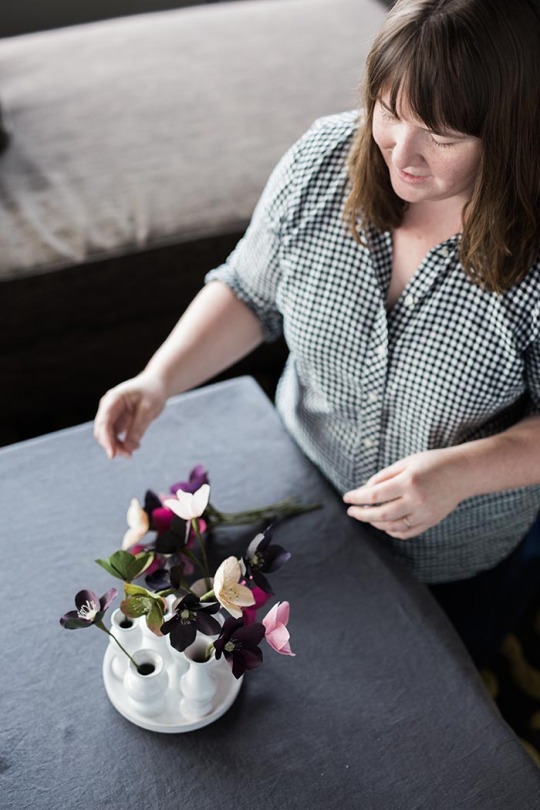
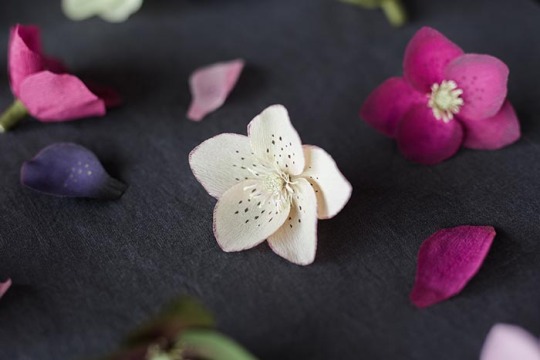
17 notes
·
View notes
Note
hi. i am the person who asked you about crosswords a long long long time ago. anyway today i thought what if i do a crossword. since i do pay for the new york times for some reason. anyway it was so so so hard. well i did solve it it just took half an hour. which is too long to be doing a crossword. do you have getting better at crossword advice. i mean. everyone calls it blackthorn not sloe. i mean the obvious answer is to do more crosswords. what i am really asking is how do i find out the things that are relevant knowledge to specifically solving this newspaper's crossword, because it must be based in some kind of cultural locale thing. thank you!
first of all i implore you to stop paying for the new york times. if you just want the crossword, it's syndicated by the seattle times for free lol
anyway, in regards to your actual question: crossword solving is absolutely a skill you can hone, and one that depends partially but not exclusively on trivia knowledge. if you keep doing crosswords, you'll definitely notice some repeat facts/words that pop up (often due in part to orthographic factors, like having a lot of common letters or a spelling with alternating vowels and consonants), and paying vague attention to the major headlines in the nyt will also, unfortunately, sometimes be helpful in solving the nyt crossword specifically. but, a lot of crosswording also just depends on becoming more familiar with the medium and its mechanics. i'm not an expert solver, but here are some tips i've picked up through trial and error (& experimenting with puzzle construction myself):
i assume you know this? but just in case: the nyt puzzle changes in difficulty throughout the week. generally the 'fill' (the answers) stays at roughly the same level of linguistic/cultural obscurity regardless of what day of the week it is, but the clues will get harder throughout the week in the sense that fewer and fewer of them will be direct questions; they'll become increasingly reliant on wordplay, puns, heteronyms, &c. monday is the easiest, saturday is the hardest; sunday is always themed, is approximately the difficulty of a wednesday or thursday, and is a 21x21 rather than the usual 15x15.
on that note, you usually want to start a crossword with a first pass in which you only fill in answers you're positive about: usually that means clues that are 'straight' (not wordplay) or are just asking for, like, celebrity names you're sure you know. on later passes, you hopefully have a few of the crossing letters, which helps narrow down punny or obscure clues.
if you're uncertain about an answer, pay attention to where you're putting certain letters relative to the rest of the grid. for example, very few english words end in the letter u, so words with a u in them are rarely the rightmost or bottommost answers next to black squares.
clues have to match their answers in tense, number, part of speech, and language (eg, 'wanted' could clue DESIRED, but not DESIRE).
clues that end in a question mark are wordplay. clues in quotes could be a book/movie/song title, but could also be asking for a verbal synonym to the sentiment expressed in quotes (eg, "cut it out!" -> STOP). clues in brackets suggest nonverbal answers (eg, [ugh!] -> GROAN). the first word of a clue will always be capitalised because it is the first word, but sometimes this is also a way of hiding ('veiling') a proper noun. eg, 'French novel' could be a particularly obnoxious way of clueing a recent tana french release (here it would also behoove you to scroll by, eg, the nyt book reviews).
rebus squares (which usually only show up on thursdays or sundays in nyt) have multiple letters in one box. the letters in the box will spell out another word or acronym that ties into the puzzle's theme somehow. occasionally the rebus square will contain a symbol that represents a word, rather than letters. you'll figure out that a puzzle has rebuses if you find yourself repeatedly trying to jam answers you're confident are correct into grid spaces that are too short. look for common letter patterns within these answers to determine which letters are supposed to go into the rebus squares.
not all nyt puzzles are themed, but when there is a theme, cracking it will help you solve a few (usually centrally-located) clues. a theme could be a certain type of pun, a set of related trivia facts, &c. generally, 3–5 answers will be themed answers (usually arranged with vertical or horizontal symmetry within the grid), and an additional clue somewhere else in the grid will give you a hint as to what pun or topic ties the themed answers together. good theme answers will also match each other in certain grammatical or semantic patterns; you'll pick this up as you complete more puzzles.
19 notes
·
View notes
Text
Rafael 'Raf' Garza
Occupation: Bartender, Photographer, Busker, Odd-Jobber Age: 28 Sexuality: Heterosexual Species: Homo sapiens Hometown: Miami, Florida Relationship Status: It is so complicated, man. Personality Traits: ++ Caring, Protective, Dutiful, Warm - - Overeager, Brash, Reckless, Stubborn

Raised in Miami at and around the turn of the millenium, Rafael Garza had a strong upbringing revolving around God and Family, even if he was never particularly devout himself - mass was always so damn gloomy, so damn concentrated on guilt and damnation, and who really had time for all that when you were coming up on the sunny south-eastern tip of the country. Still, any real differences of opinion between Raf and his family were superficial at best; he had a good childhood, with parents who did their best to provide, grandparents who did their best to impart knowledge and values, and a genuine and friendly nature that earned him friendship easy. A shifting economy and shifting career path saw him and his folks pull up roots as he made the jump from elementary to high school, taking him away from sunny Florida and dropping him dead center in the rainy, sun-starved climes of Seattle.
It was a culture shock, yeah, and the first time Raf had ever really felt lonely, east and west coast sensibilities crashing, a sudden slump in confidence turning him a bit more in on himself for a few years - he found art - lots of it. He found work, too - his parents thinking it was important for him to work early and build his work ethic up. It was in his freshman year he met Theodora, learned quickly that she was picky about nicknames, and only just after that that he was head over heels. For her energy. For her exuberance. Gosh, just for her. And then it’s been ten years and he’s had as many life’s callings as he’s had fingers. He's happy with a humble life. He's happy with her. She's seven years in a derby league and he never misses a single game. They decide to start a family. A little pack of their own, Theo says. And it’s great - it’s all great until suddenly it isn’t. Some fucking animal gets her, and it’s all downhill from there. The baby’s fine, til it isn’t. Til one month later he’s pushing a fucking couch against the door of their apartment bedroom and screaming at the thing on the other side of the door. The next time he sees Theo and he’s begging her to let him help - how? He doesn’t know, but he can’t not. She’s everything to him. She has his son in her belly - how can he do nothing?
But she tells him there’s nothing he can do but get away. But, he’s stupid and he’s in love and so he… well. He did construction and drywall for a while - the landlord had trouble buying that some wild animal did what was done to their apartment, and the security deposit - psh, that was gone - but he offered to fix it all, and he fixed it all. But after a couple months of trying to pretend this wasn’t happening - Theo… left. Said somebody told her a place to go, that she was going to go, and that he couldn’t follow.
And she left. She left him in Seattle for someplace in Oregon. She makes him promise not to follow, and promises that she’ll come back when it’s safe. But it’s not ever safe - not for like, a year. And he can’t talk about this with anyone and he can’t really talk her out of staying there and there’s only so long he can bear to watch his son and the woman he loves through the screen of a telephone or a shitty laptop while he lies to his family about Theo dealing with family problems. So he quits his job, he dips into savings and breaks his lease, and he tells his folks he’s got a job opportunity in Portland - more lies, yeah, but maybe he can do… something - anything.
2 notes
·
View notes
Text
WIP Wednesday
Tagged by the beloved @beaconfeels to share a wip--so here's more twilight.
They don’t drive for long, just around the neighborhood as Stiles familiarizes himself with the car and Allison tells him all the tips and tricks of it. They seem to slip back into the dynamic they had six years ago, like they never stopped talking or being friends, and Stiles is glad for it. It’s been so long since he’d lived there, so used to Seattle and the ease at which one could lose themselves in the big city, it’s peculiar to be somewhere where everyone knows everyone again. They come back just before the sun sets, sky darkening and stars beginning to come out. His dad and Chris are sitting on the porch chairs, a soda each hanging from their hands. Chris and Allison head out not long after, and Stiles trades phone numbers with Allison before she leaves. Stiles and his dad watch the Argents drive out, the cold air starting to seep into Stiles’s bones the longer he’s out. “D’you have fun?” Dad asks awkwardly. This is where the true challenge begins, learning who his dad is now and learning how to live together again. After the drive with Allison, though, Stiles feels like maybe he’s ready to start. Like this wasn’t a mistake. “Yeah. She’s just like I remember, just taller.” Stiles responds. “Thank you,” he starts, “for the jeep.” Dad smiles wryly at him, face softened with something like fondness, “She would’ve wanted you to have it.” His dad says it like it doesn’t pain him to talk about her, to even invoke her memory. As if the last time Stiles had seen him, he wasn’t a drunken mess at just the thought of her. Maybe his dad was better–sober–now. Stiles hadn’t seen even a bud light in the house, and he and Chris had been sipping on coca-cola rather than beer. Stiles lets himself feel the warmth of their closeness in the night, leaning against his dad’s shoulder as they gaze up at the stars.
A little late to the party (work ran late, whoops), so it's not really wip WEDNESDAY anymore, but hey! time is a social construct anyway.
2 notes
·
View notes
Text
The Empire State Building: A Timeless Icon of New York City
The Empire State Building is more than just a skyscraper—it’s a symbol of New York City's ambition, innovation, and architectural brilliance. Standing at 1,454 feet tall, this Art Deco masterpiece has been an essential part of the city's skyline since its completion in 1931. Whether you're visiting for the breathtaking views, the rich history, or simply to check off a bucket-list destination, the Empire State Building offers an unforgettable experience.
A Marvel of Architecture and Engineering
When the Empire State Building was completed, it held the title of the world's tallest building for nearly 40 years. Designed by the architectural firm Shreve, Lamb & Harmon, this towering structure was built in just 410 days—an engineering feat even by today’s standards. Its sleek Art Deco design and distinctive spire make it one of the most recognizable buildings in the world.
Inside, visitors can admire the beautifully restored lobby, featuring stunning ceiling murals and elegant marble finishes. The building’s commitment to preserving its historical charm while incorporating modern amenities makes it a true architectural gem.
Unmatched Panoramic Views of NYC
One of the main reasons visitors flock to the Empire State Building is for its spectacular views. The building has two observation decks:
86th-Floor Observation Deck – This open-air deck provides a 360-degree view of New York City, offering sights of Central Park, the Statue of Liberty, Times Square, and beyond.
102nd-Floor Observatory – Located near the top of the building, this enclosed deck offers an even higher vantage point, allowing visitors to see as far as 80 miles on a clear day.
No matter which deck you choose, the view is absolutely breathtaking, especially at sunset or nighttime when the city lights create a mesmerizing spectacle.
A Place of History and Pop Culture
The Empire State Building has been featured in countless movies, TV shows, and pop culture moments. Perhaps its most famous appearance was in King Kong (1933), where the giant ape climbed to the top. Other movies like Sleepless in Seattle, An Affair to Remember, and Elf have cemented its place as a romantic and cinematic landmark.
In addition to Hollywood fame, the building has witnessed historic events, from wartime aircraft crashes to dazzling light displays celebrating holidays and world events. Its enduring presence makes it a living testament to New York’s resilience and cultural significance.
The Mesmerizing Light Displays
One of the most captivating features of the Empire State Building is its ever-changing LED light displays. These dazzling lights celebrate major holidays, sporting events, and cultural moments. From red, white, and blue on Independence Day to rainbow colors for Pride Month, the building’s illuminations always add an extra layer of magic to the New York skyline.
A Must-Visit for Every Traveler
Visiting the Empire State Building is an experience like no other. Here’s why it should be on every traveler's itinerary:
Breathtaking Views – Enjoy unparalleled views of NYC and beyond.
Rich History – Walk through exhibits showcasing the building’s past and construction.
Romantic Spot – A favorite location for proposals and date nights.
Pop Culture Icon – Stand where movie legends have stood.
Interactive Experience – Learn about NYC’s skyline with digital touchscreens and displays.
Plan Your Visit
To make the most of your visit, consider these tips:
Best Time to Visit: Early morning or late evening to avoid crowds.
Ticket Options: Choose between the 86th and 102nd floors or go for a VIP experience.
Weather Considerations: Visit on a clear day for the best visibility.
Whether you’re a first-time tourist or a lifelong New Yorker, the Empire State Building never loses its charm. Standing atop this legendary skyscraper, overlooking the city that never sleeps, is an experience that will stay with you forever.
#EmpireStateBuilding#NewYorkCity#NYCSkyline#IconicLandmarks#NYCViews#VisitNYC#NYCTravel#KingKongBuilding#NYCTouristAttractions#ArtDecoArchitecture#CityLights#BucketListDestinations#RomanticNYC#NYCSunsetViews
0 notes
Text
Glamourous Geography: How 3 Iconic U.S. Cities Wear Denim Fashion
Almost every it-girl in New York City has a stunning floor-length jacket, and every L.A. influencer has an incredible collection of oversized sunglasses. While city-specific style trends are usually born out of practicality, they also contribute to a city's unique style.
As one of the most practical, timeless, and trendy fabrics, denim is a fashion staple in cities across the U.S.—and every city has its own way of styling it. Ready for a glamorous geography lesson? Here’s how it-girls in three major U.S. cities wear denim.
Stealth Wealth Street Fashion: New York City
The streets of New York City are ripe with outfit inspiration. Just like you can find any cuisine, style of music, or type of art within this fashion capital, you can also find nearly any aesthetic. However, one timeless look is synonymous with the city that never sleeps: the stealth wealth aesthetic.

This luxurious aesthetic is all about combining elegant and practical pieces, making denim essential. Choose well-constructed pieces that feel like they were made for you, such as mid rise butt lifting jeans crafted with innovative fit solutions. Pair your figure-flattering jeans with a silk blouse, glossy penny loafers, and delicate jewelry. Add a stylishly slouchy outer layer, such as a duster or blazer, for a look worthy of hailing a cab in Manhattan.
Vintage Hollywood Glam: Los Angeles
From its sun-soaked beaches to stunning landmarks, Los Angeles is an iconic city. While the diverse landscapes around the City of Angels made it a prime location for the film industry, this mix of city streets, sandy beaches, and rolling hills also makes the Los Angeles fashion scene incredibly distinct.
While there are plenty of aesthetics in this iconic city, one classic look is always in style: vintage Hollywood glam. Think statement accessories, textured fabrics, and just a touch of glitter—all balanced out by a grounding piece of denim fashion. To rock this timeless style, pair your favorite curvy jeans with a sleeveless mock neck. Add a pair of tortoiseshell oversized sunnies, simple ballet flats, and a glittery accessory to achieve an actress-off-duty aesthetic.

Earthy Elegance: Seattle
This gorgeous gem of a city is surrounded by green forests and quaint coastal towns. Not only is Seattle home to the iconic Space Needle and eclectic Pike Place Fish Market, but this city is also the birthplace of everyone’s favorite coffee shop.
Seattle fashion focuses on blending sensible styles with cutting-edge trends, making denim an integral part of this city’s look. For an outfit that seamlessly transitions from chilling in a coffee shop to strolling along a waterfront walkway, style a flattering pair of wide leg jeans with your favorite boots, a vintage band tee, and a cozy flannel.
Whether your outfits stop traffic in Seattle or catch eyes on New York City crosswalks, one thing is certain: Every city in the U.S. has a unique sense of style. With these three trendy tips, you can feel like a well-traveled it-girl, no matter where you wear your favorite jeans.

About YMI Jeans
Your captivating style is an outward expression of your inner beauty, which is why YMI Jeans offers accessible, inclusive fashion that helps women look and feel their best. This Los Angeles-based denim brand was founded in 2000 during a sensational period of fashion and pop culture. While they stay true to their Y2K roots, YMI Jeans is constantly evolving. With innovative fit solutions, high-quality fabrics, and meticulous attention to detail, this iconic brand designs clothing that celebrates timeless looks and emerging trends. The Denim Style Quiz and the Denim Fit Guide on the YMI Jeans website make it easy to find your dream styles, whether you’re looking for petite or plus size jeans. To cultivate a sense of style that is effortlessly on-trend yet one-of-a-kind, turn to YMI Jeans.
Find jeans that speak to your city’s style at https://ymijeans.com/
Original Source: https://bit.ly/4h2rdNU
0 notes
Text
Designing a Custom Home in Seattle’s Urban Environment: A Comprehensive Guide

With its vibrant urban area, interesting neighborhoods, and breathtaking waterfront views, there is no better place to create custom homes that are finely detailed and reflect the character of the city that surrounds you. Whether you choose a high-rise retreat or a suburban oasis, working with the best custom home builder Seattle has to offer guarantees that your dream home integrates effortlessly into Seattle’s exhilarating urban atmosphere.
In this piece, we’ll examine everything it takes to design a custom home in Seattle: the challenges and advantages of building in an urban environment, finding quality home builders in Seattle, and advice on making your new home stand out and contribute to the community.
1. Why Build in Seattle’s Urban Landscape?
This makes Seattle’s urban environment an exceptionally provocative and challenging canvas for custom home design. In Seattle, from its downtown teeming with activity to its residential enclaves like Capitol Hill and Ballard, there are all sorts of possibilities for designing homes that reflect the city’s soul. As urban dwellers try to mix the attraction in a town with the necessity for comfort, fashion, and eco close to home, the desire for modern, environmentally appropriate housing spaces is stronger than ever.
Building a custom home in Seattle allows homeowners to:
Be unique with the personal statement using unique architectural features.
Use a prime location near city services, transportation, and entertainment.
Making the most of unusual spaces while learning to reuse and limit material is part of optimistic living architecture and can minimize environmental impact.
Yet the process of building a home in Seattle's urban environment entails knowledge of local building codes and a sense of the city's current aesthetic trends, which themselves are shifting. Here’s where a seasoned custom home builder near me comes in. With a local expert, you can navigate these challenges while making sure your vision is not just realized but realized flawlessly.
2. For urban challenges in Seattle home design understanding
When designing a custom home, there are a few challenges to remember based on Seattle’s geography and urban density. Architects and home builders in Seattle have to find creative ways to utilize narrow plots, city zoning regulations, and the fact that the city lies on steep hills to maximize the space it occupies while reminding it of its architectural identity.
Key considerations include:
Zoning and Permitting: Seattle has strict zoning laws that dictate different types of construction in other neighborhoods. A custom home builder in Seattle can guide you through all of this, so you don't have to navigate the process alone as you go through the legal requirements of designing a new home.
Space Utilization: The lots in the cities are small and irregular in shape, so to maximize the space available, we need to come up with homes on the lots. Maximum living areas are achieved with innovation using multi-functional rooms and vertical expansion.
Sustainability: Increasingly, Seattle residents are seeking eco–friendly living spaces. In custom home design, selecting sustainable materials and designing energy energy efficient into your fore is common. Solar panels, rainwater harvesting systems, and green roofs are some elements that can help reduce your new home's environmental footprint.
3. Selecting the right custom home builder for your project
If you live in Seattle, picking a custom home builder near me is undoubtedly one of the main steps in your home design journey. So, with many builders, it can be hard to find the right one. Here are some tips for selecting the ideal partner to bring your vision to life:
a. Specializing in Urban Home Design
Not all home builders in Seattle are familiar with the complexities of urban design. Find someone experienced in building in Seattle’s metropolitan areas. They would have to know local zoning laws, permitting, and the challenges of working with smaller or complex pieces of land.
b. Completed Projects Portfolio
One of the best ways to learn about a builder’s experience and design abilities is to review their portfolio. A good custom home builder in Seattle should be able to produce several successful projects with your desired architecture or style, whether contemporary, minimalist, or traditional. In their work, they pay attention to the finishes, craftsmanship, and attention to detail.
c. Reputation and reviews
Look for work done by the builder online, check online reviews, ask for references, and talk to previous clients to see how the builder worked. Good Home Builders Seattle will have a demonstrated track record of completing projects on time and within budget and an identity as a communicator and team player.
d. Sustainability Focus
However, with Seattle being a very green location to live in, it's essential to find a builder who has lots of experience when it comes to building a home with green techniques. Find a custom home builder near me who can help you choose environmentally friendly materials and energy-saving systems that correspond to your green views.
4. The key features you should add to your custom home design are:?
Several features are unique. A number of features are unique to designing a custom home in Seattle’s urban environment. By including these elements, your living experience will be raised, and your home should also mirror the Seattle design sensibilities.
a. Open Floor Plans
Open floor plans in urban homes make small spaces feel larger and have an airier look. Large windows, many of which take advantage of the opportunity to frame the cityscape or scenic views, allow for the most significant amount of natural light to enter.
b. Indoor-Outdoor Flow
Seattle’s temperate climate lends itself well to constructing homes that blur the line between inside and outside. Many custom homes include mega decks, patios, or balconies that could be used for entertaining or just relaxing and taking in the views of the city and beyond.
2. Smart Home Technology
Modern custom homes must undoubtedly include the use of smart home technology. Home automation systems let homeowners easily control lighting, security, climate, and more. A custom home builder in Seattle can make your home energy and smart tech-efficient and prevent your home from being outdated.
d. Sustainable Materials
Since Seattle residents are environmentally conscious, you can’t be surprised that some custom homes are built with sustainable materials like bamboo flooring, recycled glass countertops, and locally sourced timber. Not only are these materials carbon-reducing and environmentally friendly, but they also provide an innate and elegant presence within the home.
e. Green Building Systems
Green buildings like solar panels, energy efficient efficient, and rain water systems are becoming common in many Seattle homes. These systems help reduce the environmental impact of a house, and they also help save money over time on utilities.
5. How to Maximize Your Investment with the Right Design?
Building a custom home in the setting of Seattle’s urban environment is an investment in lifestyle and returns in financial value. While finding that balance between cost, quality, and design is complex, working with a home builder in Seattle can help you do so. If you think hard about maximizing space, adding sustainable features, choosing the right location, and the like, you can build a house that may meet your needs and appreciate the long haul.
Tips for Maximizing Your Investment:
Focus on Energy Efficiency: Seattle’s cool and rainy weather puts energy-efficient demands on energy-efficient homes lower utility bills and attractive homes you may have in the future.
Select Timeless Design Elements: You don’t have to hate every current trend, but timeless design elements like clean lines, neutral colors, and high-quality finishes can help your home get a longer life span.
Prioritize Location: Location is everything in Seattle's urban environment. Ensure your custom home has easy access to transportation, work, and entertainment as you choose a site.
Conclusion
Building a custom home in a Seattle urban environment is exciting yet challenging. A well-chosen custom home builder in Seattle will be the key to a successful project, someone who understands the complexities involved with urban construction and can deliver a home that fits your tastes and follows the demands of the constantly evolving city.
When you work with a home builder in Seattle, your custom home can look great, be integrated into Seattle’s unique urban fabric, and achieve long-term comfort, sustainability, and value. Working with a trusted builder would give you a dream home if you are seeking a high-tech and eco-friendly design or a space quite adaptive to Seattle’s natural beauty.
Have you been looking for someone to start your custom home design with? If you live in Seattle, contact a custom home builder near me to begin designing your future today.
#Custom Home Builder Seattle#Home Builders Seattle#Custom Home Design Seattle#Seattle Urban Home Design#Building a Custom Home in Seattle#Urban Custom Homes#Seattle Architecture#Custom Homes in Seattle#Sustainable Home Design Seattle#Modern Home Builders Seattle#Home Design in Seattle#Seattle Custom Home Contractors#Eco-friendly Homes Seattle#Sustainable Home Builders Seattle#Luxury Home Builders Seattle#Urban Living Seattle Homes#Custom Home Builders Near Me#Custom Home Construction Seattle#Seattle Residential Architecture#Seattle Home Design Trends#Design Your Dream Home Seattle
0 notes
Text
Winterizing Your Generator: Essential Maintenance Tips to Keep Your Home Powered Up
Winter is upon us, and ensuring your home stays powered during harsh weather is crucial. For residents in the Pacific Northwest, where storms and outages can strike unexpectedly, maintaining your generator is a vital part of winter preparedness. Skyline Constructions Services specializes in ensuring reliable generator installation Bellevue WA, Everett WA, Marysville WA, Seattle WA, and Woodinville WA, and we're here to help you keep your equipment in top shape.
#generator installation bellevue wa#generator installation everett wa#generator installation seattle wa#generator installation marysville wa#generator installation woodinville wa
0 notes
Text
How to Choose the Best Remodeling Contractor in Seattle, WA: A Comprehensive Guide

The right remodeling contractor ensures that your home makeover in Seattle, WA, is booming. If you are thinking of changing your kitchen, bathroom, or the whole house for the better, choosing a good contractor is crucial to avoiding the many pitfalls of the renovation. This guide will provide honest information on looking for the right remodeling contractor in Seattle, WA, and getting your dream home.
Understand Your Project Goals Before Hiring
Before you get a pen and paper to search for the best Seattle remodeling contractor, you must determine the type of remodeling you need. Some contractors only focus on specific home areas, such as the kitchen, the bathroom, or the house.
Tip: If you’re working on a particular area of your home, like when doing a custom bathroom remodel, you should look for specialized contractors.
Search and Read Reviews
Referral and feedback feedback are the best methods of identifying a contractor, including word of mouth and online reviews. You can get recommendations from your friends, family, or neighbors, and you can also check Yelp, Google Reviews, or Angie’s List to see what people say about contractors.
Tip: Search the feedback for positive values recommendations, including professionalism, punctuality, and detail. The lousy side also has information that could be useful to know about a particular business or product.
Check-On Credentials and Licensing
Make sure the contractor is licensed, bonded, and insured. A licensed Seattle remodeling contractor has undergone training and is up to date with the local code requirements, thereby minimizing risks in your project.
Tip: You should always get a certificate of insurance and certification of the person’s license before signing any contracts. A genuine contractor will not hesitate to give such information to the client.
Review the Previous Work Portfolios
Request previous projects from contractors that they have done recently. Comparing the before-and-after pictures of projects similar to yours is also a good way of judging their skill and design preferences.
Tip: Search for projects that are in your taste, ranging from simple kitchen renovations to reconstructing older homes.
Request for Estimates and Compare Them
Get a detailed estimate from the Seattle remodeling contractors you have listed. These should include labor, material, time for execution of the project, and any other charges that may be there.
Tip: Do not base your decision on the lowest bidder. An underestimate could be due to using substandard materials or fast completion of construction work.
Assume Key Questions During Consultations
When you have your list of the best contractors, arrange for them to see your project. Here are some questions that you should ask them during this stage of your remodel project:
Sample Questions to Ask:
What is the duration you have been in business in the remodeling industry?
I would like to ask for client references or any testimonials you may have.
Will you hire sub-contractors or do the work with your personnel?
When will the project be completed?
Ensure You Read Through the Contract With A Lot Of Attention
Before starting the job, it is better to read the contractor agreement carefully. A good contract should describe the agreed project, the payment plan, the time frame, warranties, and the anticipated behavior of both parties.
Tip: There is a saying that one should not start a project without a signed contract. When there are clear documents, there will be no confusion that may lead to misunderstandings.
Communication Skills Should Come First
Effective communication is crucial, particularly in a remodeling project. You should demand that your contractor give you progress reports and also answer any questions you may have.
Tip: It is recommended to state which means of contact is preferable: telephone, email, or a personal meeting.
Manage Realistic Expectations of Time
A Seattle remodeling contractor with good experience will provide the client with a reasonable time to complete the project. Unfortunately, some setbacks are bound to occur, but a good contractor will communicate these to you and ensure they work as much as possible within the set time frame.
Tip: Avoid contractors who offer quick delivery times as much as possible because fast delivery may mean poor construction.
Make an Informed Decision
Develop a list of questions you need to ask the contractors. After comparing estimates, reviewing portfolios, and evaluating communication skills, choose a contractor with your vision that falls within your budget and can meet your project time frame.
Why Selecting the Right Contractor Matters:
It prevents you from losing your money by getting low-quality work.
Stress is easily managed when proper communication and expectations are appropriately set.
It allows you to bring your dream renovation to life without unnecessary delays or higher costs.
Are You Looking for a Seattle, WA Remodeler to Help You Get Started?
Remodeling your home is an investment, and there is no one better to do it than the best remodeling contractor in Seattle, WA. You have to invest time in checking credentials, asking questions, and ensuring that you deal with a reputable contractor.
Take Action Today: To get a free consultation with one of Seattle’s most reputable remodeling contractors, call us, and let us help you create the home of your dreams! learn more.
#Seattle remodeling contractor#Best remodeling contractors in Seattle#Home remodeling in Seattle#WA#Kitchen remodeling Seattle#Bathroom remodeling Seattle#Licensed remodeling contractors Seattle#Top remodeling services Seattle#Home renovation Seattle#How to hire a remodeling contractor Seattle#Seattle home improvement tips#Custom remodeling services Seattle#Reliable contractors Seattle#Remodeling contractor reviews Seattle#Affordable remodeling contractors Seattle#Expert remodeling contractors Seattle#Residential remodeling Seattle#Professional home remodeling Seattle#Best home renovation services Seattle#Contractor licensing Seattle#Remodeling project tips Seattle
0 notes
Text
Seattle Building Permit Requirements: A Homeowner’s Guide

Are you building or renovating a home in Seattle? The city’s building permit requirements can seem overwhelming at first, but they’re an essential step to ensure safety, legality and a smoother project all around. We will break this down into smaller pieces to make things more understandable.
What Does It Matter To Get Building Permits?
Building permits are important because:
Ensuring compliance: They make sure construction adheres to city codes and standards.
Protect Your Investment : Permits protect the structural integrity of your property.
Avoid the legal issues: Many entities may fine you for skipping permits or delay the project, or even make you tear down unpermitted work.
When Do You Need a Permit?
Here’s a brief list of projects that need a permit in Seattle:
New Construction (residential structures over 120 sq. ft. including garage)
Structural changes: Changing walls, beams, or floors.
Plumbing and Electrical Work: Installation or alteration of systems.
Extensions: Building more space to your existing home.
Decks and Fences: There are structures above a set height.
Accessory Dwelling Units (ADUs): Basement apartments, backyard cottages.
Tip: You don’t need a permit for every project. Cosmetic changes and minor repairs are frequently exempt, though, so check with the Seattle Department of Construction and Inspections (SDCI).
Types of Building Permits
Depending on your project, these are some permits:
Building Permit: For large remodels or new construction.
Electrical Permit: Only needed if doing wiring or electrical updates.
Plumbing Permit: For changes to water, sewer, and gas lines.
Mechanical Permit: HVAC installation or alteration.
Land Use Permit: Required when projects that affect zoning or landscaping.
Guide to Obtaining a Building Permit in Seattle
Here are steps to make your process a seamless one:
Research Requirements: Check out the SDCI site to see what permits your project requires.
Prepare Your Documents: Detailed plans are essential. These can include site plans, construction drawings and compliance forms.
Submit Your Application: Apply online using the Seattle Services Portal. Make sure to include all required documents to prevent any delays.
Pay Fees: Charges vary based on the scope of your project. Estimate costs using the SDCI fee calculator.
Wait for Approval: For small projects, permit approval can take a few days; for larger, several weeks.
Schedule Inspections: Once the work starts, you still have to have inspections to make sure everything is up to the approved plans.
Common Pitfalls and How to Avoid Them
Inadequate Plan: Missing information can delay approvals. Consult a professional to make sure you will document extensively.
Delays in Permits: Begin your application process early so you can avoid setbacks.
Non-Compliance: Ensure your project complies with Seattle’s zoning and environmental regulations.
Everything You Need to Know About the Permit Process
Start Well Ahead: Don’t wait until the last minute; getting a permit approved can take a long time.
Consult Experts: Architects and contractors can help streamline the process and save you expensive mistakes.
Be organized: Have a way to track all your documents, plans, and inspections.
Final Thoughts
Navigating the ins and outs of Seattle building permit requirements can be a bit of a hurdle, but it’s a crucial step in making your project a success. Whether you’re constructing a new house or adding a backyard cottage, working your way through the process ensures safety, compliance and peace of mind.
Ready to take the next step? Go to the SDCI website or consult with a pro to help you navigate. The project you dream about is totally possible with some preparation.
#home decor#home & lifestyle#renovation#construction#home design#room decor#buildings#real state#washington state#home permit#interior design#interiorstyling#interior decorating
0 notes
Text
Open Your Career: Top Nursing Homes Offering CNA Training Programs
Unlock Your Career: Top Nursing Homes Offering CNA Training Programs
In today’s competitive job market, the healthcare industry stands out as a thriving field for job seekers. As a Certified Nursing Assistant (CNA), you can enjoy a rewarding career while making a difference in the lives of patients. In this article, we explore some of the top nursing homes offering CNA training programs and how you can unlock your career potential in this fulfilling profession.
Why Choose a Career as a CNA?
Before diving into our list of the best nursing homes, let’s discuss the compelling reasons to pursue a career as a CNA. Here are some key benefits:
High Demand: The demand for CNAs is projected to grow due to the aging population.
Short Training Period: CNA programs typically require only 4-12 weeks to complete.
Job Satisfaction: Helping others can be a deeply fulfilling experience.
Flexible Work Hours: Many facilities offer various shifts to cater to diverse schedules.
How to Choose the Right CNA Program
Choosing the right CNA training program is crucial for your career. Here are some tips:
Accreditation: Ensure the program is accredited by a recognized body.
Location: Consider programs close to your home to ease commuting.
Job Placement Rate: Research the school’s job placement success rate.
Tuition and Financial Aid: Look for programs that offer financial assistance.
Top Nursing Homes Offering CNA Training Programs
Here’s a selection of nursing homes known for their exceptional CNA training programs:
Nursing Home
Location
Duration
Certification
Tuition Fee
Green Meadow Nursing Home
Springfield, IL
6 Weeks
State Approved
$800
Sunny Acres Care Center
Orlando, FL
4 Weeks
State Approved
$600
Oakwood Rehabilitation Center
Atlanta, GA
8 Weeks
State Approved
$1000
Riverside Nursing Facility
Denver, CO
5 Weeks
State Approved
$700
Silver Lake Health Center
Seattle, WA
7 Weeks
State Approved
$850
Hands-On Training and Experience
Practical experience is essential for a successful career as a CNA. Many programs include clinical training as part of their curriculum, ensuring you gain real-world experience. This hands-on training allows you to:
Develop Skills: Get accustomed to daily nursing tasks like bathing, feeding, and monitoring patients.
Understand Patient Care: Learn to interact with patients compassionately and professionally.
Build Confidence: Familiarize yourself with the workplace environment before graduation.
Real Experiences: What CNAs Say About Their Training
Many CNAs share positive experiences about their training programs. Here are some insights:
“The hands-on experience in my CNA program was invaluable. It truly prepared me for the challenges of the job.” – Sarah K., Current CNA
“I was able to find a job right after graduation, thanks to the connections my nursing home provided.” – Mike A., CNA graduate
Tips for Succeeding in Your CNA Career
Once you’ve completed your training and landed a job, keep these tips in mind for success:
Continuous Learning: Stay updated on best practices in patient care.
Build Relationships: Create positive connections with colleagues and patients.
Seek Feedback: Use constructive criticism to improve your skills.
Stay Organized: Maintain meticulous records for better patient care.
Conclusion
Becoming a Certified Nursing Assistant is an excellent way to start a fulfilling healthcare career. With numerous nursing homes offering CNA training programs, aspiring CNAs can find the ideal course to kickstart their journey. By choosing accredited institutions, attending hands-on training, and cultivating relationships in the field, you can take the first step toward a rewarding career dedicated to caring for others. Start your journey today and unlock the potential of your career!
youtube
https://cnacertificationprogram.net/open-your-career-top-nursing-homes-offering-cna-training-programs/
0 notes
Text
Essential Questions to Ask During Your Kitchen Remodeling Consultation

Planning a kitchen remodeling project can be a game-changer for your home, offering a fresh, functional space that suits your lifestyle. Before diving in, it’s crucial to make the most of your initial consultation with a contractor. Asking the right questions helps you understand the process and ensures that both you and your contractor are on the same page. Here are some key questions to consider during your consultation.
What’s the Estimated Timeline for My Project? One of the first things you’ll want to know is how long your kitchen remodeling project will take. Understanding the timeline gives you a clear idea of what to expect and helps you plan for any temporary changes to your routine. Ask your contractor about the time required for each phase, from design to demolition to installation, so you can manage your expectations and plan accordingly.
How Do We Stay Within My Budget? Budget is often a top concern when it comes to kitchen remodeling. During your consultation, ask your contractor how they plan to keep the project within your financial limits. They can provide tips on where to save and where it might be worth splurging. This conversation ensures that you get the most value from your investment without compromising on quality or style.
What Design Ideas Do You Recommend? Your contractor brings a wealth of experience and creativity to the table, making them a great resource for design inspiration. Ask them about ideas they think would work well in your kitchen. They might suggest layout adjustments, materials, or finishes that you hadn’t considered. This back-and-forth can spark new ideas, resulting in a kitchen remodeling plan that you’re excited about.
Will I Need Any Permits for This Project? Kitchen remodeling projects often involve structural changes, electrical work, or plumbing updates, which may require permits. Ask your contractor if any permits are needed and how they will handle the process. Knowing this upfront helps prevent delays down the line and ensures that everything is done according to local regulations.
How Will We Communicate Throughout the Project? Clear communication is essential for a smooth remodeling experience. Ask your contractor how they plan to keep you updated on the progress of your kitchen remodeling. Will there be regular meetings, phone calls, or emails? Understanding how you’ll stay in the loop helps prevent misunderstandings and keeps everything on track.
What Is Included in the Estimate? It’s important to know exactly what you’re paying for. During the consultation, ask your contractor for a detailed breakdown of the estimate. This should include costs for materials, labor, and any potential additional expenses. Understanding what’s included can help you avoid unexpected costs later in the process.
Can I See Examples of Your Previous Work? Experience matters when choosing a contractor for your kitchen remodeling. Ask to see photos or visit completed projects they’ve worked on. This gives you an idea of their style, attention to detail, and quality of work. It also helps you feel confident that you’re working with someone who understands your vision.
Moving Forward with Confidence Your initial consultation is your chance to gather the information you need to make informed decisions about your kitchen remodeling project. By asking the right questions, you can ensure that your contractor is the right fit for your needs and that you’re both aligned on the project’s scope, budget, and timeline. With clear communication and a solid plan, you’ll be on your way to creating the kitchen you’ve always dreamed of. Ready to take the next step? Reach out today and start your journey to a beautiful new kitchen.
#kitchen remodeling#kitchen renovation#kitchen design#kitchen upgrades#custom kitchen#kitchen makeover#modern kitchen remodeling#small kitchen remodeling#luxury kitchen#kitchen cabinets#kitchen countertops#kitchen layout#kitchen flooring#kitchen lighting#kitchen appliances#open-concept kitchen#kitchen island installation#affordable kitchen remodeling#professional kitchen remodeler#kitchen space optimization#kitchen remodel ideas#eco-friendly kitchen remodel#contemporary kitchen design#kitchen style transformation#kitchen backsplash#personalized kitchen design#kitchen renovation contractor
0 notes
Text
The Ultimate Guide To Shipping Containers

Further exploring the realm of shipping containers:
Case Studies and Success Stories:
Container City, London: Located in the heart of London's Docklands, Container City is a vibrant community built entirely from repurposed shipping containers. The project showcases innovative design and sustainability principles, providing affordable live-work spaces for artists, entrepreneurs, and small businesses.
Starbucks Shipping Container Stores: Starbucks has embraced container architecture as a way to expand its presence in unconventional locations while minimizing environmental impact. Container-based Starbucks stores have been successfully deployed in various cities worldwide, including Seattle, Denver, and Taiwan.
Puma City, Boston: Puma City is a mobile retail and event space constructed from 24 shipping containers. The innovative design features a dynamic façade that opens up to create a large outdoor plaza, hosting events, pop-up shops, and promotional activities for the Puma brand.
The Cove, Houston: The Cove is a mixed-use development in Houston, Texas, comprising retail, office, and residential spaces constructed from repurposed shipping containers. The project demonstrates how container architecture can revitalize urban areas, foster community engagement, and support local businesses.
Container Terminal Park, Seoul: Located along the Han River in Seoul, South Korea, Container Terminal Park is a public park built on a former industrial site. The park incorporates shipping containers into its design, repurposing them as cafes, galleries, and recreational facilities, while preserving elements of the site's industrial heritage.
Educational Resources and Training:
Container Architecture Workshops: Various organizations and educational institutions offer workshops and training programs focused on container architecture, covering design principles, structural engineering, permitting processes, and hands-on construction techniques.
Online Courses and Webinars: Platforms such as Coursera, Udemy, and LinkedIn Learning offer online courses and webinars on container-based construction, sustainable design, and project management. These resources provide accessible and flexible learning opportunities for architects, builders, and enthusiasts.
Professional Associations: Joining professional associations such as the Container Architecture Network (CAN) or the American Institute of Architects (AIA) can provide valuable networking opportunities, resources, and continuing education for individuals interested in container architecture.
Design Publications and Journals: Stay informed about the latest trends and developments in container architecture by subscribing to design publications, journals, and online forums. These resources feature case studies, interviews with industry experts, and design inspiration for container-based projects.
DIY Resources and Communities: For DIY enthusiasts and self-builders, online forums, blogs, and social media groups dedicated to container architecture offer a wealth of information, tips, and inspiration for planning, designing, and constructing container-based structures.
By leveraging these resources and learning opportunities, individuals and professionals can acquire the knowledge, skills, and inspiration needed to embark on successful container-based projects and contribute to the continued evolution of this innovative and sustainable building approach.
0 notes
Text
Finish carpentry is a refined craft that focuses on the intricate details and aesthetics of a construction project. Unlike rough carpentry, which deals with structural elements, finish carpentry involves the installation of final touches that enhance the visual appeal and functionality of a space. Skilled finish carpenters meticulously work with materials such as wood, molding, trim, and decorative elements to create seamless transitions between surfaces, conceal imperfections, and add character to interiors. From installing baseboards and crown molding to crafting custom cabinetry and intricate woodwork, finish carpentry requires precision, attention to detail, and a keen eye for design. The expertise of finish carpenters is often showcased in the flawless execution of trim work, staircases, doors, and windows, elevating the overall aesthetics of residential and commercial spaces alike. Whether it's creating elegant paneling, fitting intricate door frames, or crafting bespoke shelving units, finish carpentry plays a crucial role in adding the final flourishes that transform a building into a polished and inviting environment.
0 notes